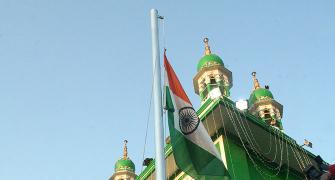Ajit Balakrishnan envisions a flag to capture the spirit of the impending conflicts of the Information Age.

IMAGES: The flag designed by Pingali Venkayya in 1921 to rally Indians around the Independence movement, left, with the charkha in the middle.
Right: Ajit Balakrishnan designs a flag to capture the spirit of the present times.
Pingali Venkayya is a man I greatly admire. He is the person who, in 1921, designed a flag to rally Indians around the Independence Movement.
His design had a stripe of saffron at the top, a band of white in the middle, and a band of green at the bottom. More importantly, probably at a suggestion of Mahatma Gandhi, he placed the charkha, the traditional yarn spinning wheel in the middle.
The logic of the design was this: The saffron and green represented the Hindu and Muslim communities that needed to be united for a future India and the charkha in the middle symbolised, in the narrative of the Indian Independence movement, the resistance to the Industrial Revolution, which, with its spinning and weaving machines that the British imperial overlords imposed on India and which displaced the charkha, thereby causing unemployment and misery for millions of Indians.
The flag, immediately adopted by the Congress at the 1921 Congress convention at Vijayawada, served as the flag of the party.
This flag, at one glance, would tell the narrative of the Indian freedom struggle to even an illiterate Indian. Fight the oppressor whose support for textile machinery has impoverished India, let's fight to get Independence from them.
Today, it serves as the national flag of India with merely the charkha replaced by the Ashoka Chakra.
Flags with symbols have long been used to harness the masses to a cause.
The Communist revolution that erupted in Russia around the same period when Venkayya designed the Congress flag chose the hammer and the sickle as its symbol, the hammer representing the interests of industrial workers and the sickle represented farm workers, both suffering from the ravages of the Industrial Revolution imposed on them by their heartless Tsarist rulers.
I sometimes wonder whether our policymakers, in their near universal enthusiasm for things Digital ('Digital India', 'egovernance', 'e-Kranti'...), have paused to examine the social landmines that exist in our path to the promises of the digital world.
For instance, multiple studies throughout the world are starting to highlight the number and types of jobs that will be threatened by the rise of Digital.
A Forrester Research report says that solutions powered by artificial intelligence/cognitive technology threatened jobs in transportation, logistics, customer service, and consumer services.
A Deloitte Insight report last year predicts that 39 per cent of the jobs in the legal profession will be eliminated in the next 10 years.
Other studies see the elimination of such prized middle-class jobs such as Insurance Underwriters and Bank Tellers.
Even low-labour cost countries are not immune: An ILO study says that one of the biggest employers in the ASEAN region, the textiles, clothing and footwear sector, is threatened by the advent of computer-aided design and robotics.
Information Age conflicts may also be at a more macro and societal level and not merely outbreaks and protests at the shop floor level.
Alec Ross, the author of the recently published book The Industries of the Future, points out that if land was the raw material of the Agricultural Age and iron that of the Industrial Age, it is Data that is the raw material of the Information Age.
We know from our Indian historical experience that in the Agricultural Age, he who controlled masses of land was the master.
Thus, landowners were looked up to with awe, they were featured in movies as heroes, a social system was developed which allowed these holders of land (zamindars as they were called in India) almost unfettered rights over the minds and bodies of other human beings who toiled on that land.
In the Industrial Age those who controlled the supply of iron, coal, and petroleum were the undisputed Rajas.
In the Information Age, those who control data will be the Rajas.
And just as wars were fought to increase acreage of land, or coal mines and crude oil sources, so can we expect some major battles around the desire to control data.
This past weekend I thought I would try and emulate Venkayya and design a flag to capture the spirit of these impending conflicts.
Here is the thinking which has gone behind my design.
What the spinning jenny did to the charkha and farm machinery did to the scythe, the algorithm has started doing to the pen.
After all, it is by wielding the pen (truthfully, the computer keyboard and word processor have not achieved much more than a ball point pen or a fountain pen beyond faithfully recording our thoughts on paper or on screen) or even a quill pen that ideas were propagated.
So, if we have to imaginatively design a flag, it must have a quill pen at its centre -- to symbolise just as the sickle, the hammer and the charkha did -- to rally the masses against digital algorithms that have already started to take away the livelihood of all those whose job is to read the material, process it in their head, and write it all down (on a piece of paper or punched into a laptop keyboard).
One should not forget that in the Industrial Revolution while the jobs and means of livelihood of hand spinners and weavers were threatened and in many cases lost, it also made cloth affordable for many segments of the population who could not afford to wear cotton clothes.
Similarly, while Information Age algorithms may threaten and possibly make many white-collar jobs like those of accountants, lawyers, doctors and clerical labour redundant, it will also possibly make all such services more reliable, more affordable, and thus used by a much higher proportion of the population than it is being used at present.
Whether the path that India takes in the Information Age emphasises the positive consequences of making professional services more reliable and affordable or whether it will result in merely job losses and impoverishment of professionals hitherto prosperous will depend how Indian policymakers act.
If they chase the wrong dreams and policies, many groups in Indian society may rally around the flag that I have designed.
If they plan policy correctly, the flag I designed will, like many creatively designed objects, remain just that: An interesting design with no practical use.
Ajit Balakrishnan, founder and CEO of Rediff.com, is the author of The Wave Rider, A Chronicle of the Information Age.
You can reach him at ajitb@rediffmail.com










